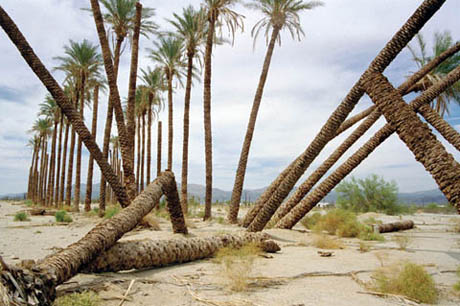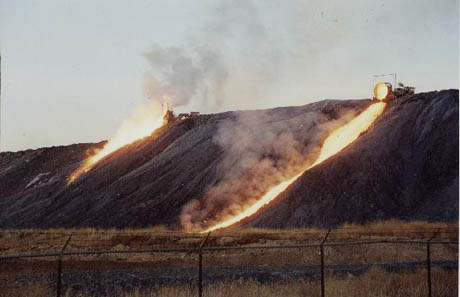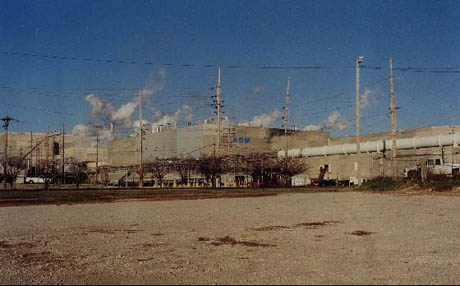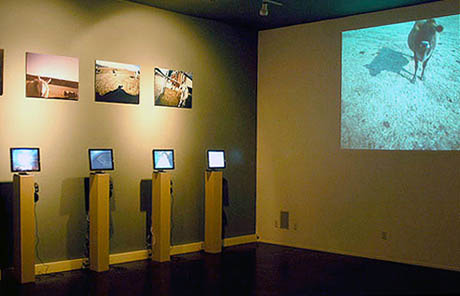
IMAGE: From Hinterlands: A Voyage into Exurban Southern California [pdf] by the Center for Land Use Interpretation.
The Center for Land Use Interpretation (CLUI), for those of you who are not yet familiar with its delights, is “dedicated to the increase and diffusion of information about how the world’s lands are apportioned, utilised and perceived.” It is also one of the treasures of Los Angeles (or Culver City, to be precise), and the enjoyment with which I recently read its Winter 2011 Lay of the Land newsletter prompted me to spend to spent a happy evening revisiting old issues and rediscovering several food-related gems.
In a 1997 field report entitled “The Unique Unnatural Attractions of Soda Springs, Idaho,” the CLUI visits a geologic artifact of agribusiness, and “a rare example of man-made molten mountain building.”
Twenty four hours a day, seven days a week, specialised trucks back up to the edge of the hill, and tip a 600 cubic foot of molten slag overboard. The glowing, thousand degree centigrade liquid slides easily down the slope, throwing heat that can be felt hundreds of yards distant. As the liquid cools and solidifies, a crackling, rock-building sound can be heard.

IMAGE: Monsanto Phosphate Plant and Slag Pour from the CLUI Land Use Database.
The slag consists of calcium silicate, a by-product of the process through which the next-door Monsanto plant produces phosphates for use in “soft drinks, insecticides, toothpaste, fertilisers, and herbicides.” The mound of cooled slag has been accumulating since the plant opened in 1952, and is apparently 150 feet high in places; its blackened surface providing a dramatic contrast to the white-hot liquid minerals that cascade down its slopes several times every hour. Bizarrely, calcium silicate is itself used in the processed food industry as an anti-caking agent (for example, according to Wikipedia, it can be found in McDonald’s Angus Beef patty seasoning).
A few years later, in Summer 2000, the CLUI paid a visit to the Decatur, Illinois, headquarters of Archer Daniels Midland, one of the largest industrial agricultural companies in the world, and the self -proclaimed “Supermarket to the World.” The complex is documented in olfactory as well as infrastructural detail, described as “an effervescent, anaerobic, enzymic, protean, protein-rich cornucopia of odours, emanating from the various states and permutations of the highly controlled organic decomposition of America’s heartland.”

IMAGE: Archer Daniels Midland headquarters from the CLUI Land Use Database.
ADM’s primary business is in the processing (or “value-adding”) that transforms bulk commodities such as corn and soy into “ingredients familiar in name to any American that reads processed food labels: citric acid and lactic acid, xanthan gum, dextrose, sorbitol, and corn syrup.” In fact, ADM is the largest high fructose corn syrup producer in the U.S., and the CLUI speculates that the East Plant at Decatur, with pipelines carrying the syrup across roadways, may well be “the largest producer of the substance in the world (ADM spokespeople are reluctant to talk about superlatives).”
Finally, although the Center’s usual focus is on understanding the ways humans interact with the North American landscape, in Winter 2003, the CLUI invited Sam Easterson to present an exhibition entitled On the Farm: Live Stock Footage by Livestock, in which “farm animals showed us their point of view, through wireless video cameras installed temporarily on their head and necks.” A chicken, a cow, a pig, a goat, a sheep, and a horse each shared their own perspective on the agricultural landscape: “what they look at, what catches their attention, how they move through space, and how they relate to one another, on the farm.”

IMAGE: On the Farm exhibit at the CLUI, photo by the CLUI.
Mountains of molten anti-caking agent, pipes full of corn syrup, and a overwhelming focus on the feeding trough: a handful of perspectives on the most pervasive form of land use in the United States from its pre-eminent chroniclers. I’m excited to say that over the coming year I’ll be working with the CLUI team to analyse and document another edible geography: the artificial cryosphere, by which we mean the network of refrigerated warehouses, trucks, and home appliances that are tied together across America in a (relatively) seamless cold chain. Watch this space — and, of course, your suggestions for interesting sites and sources would be much appreciated.

